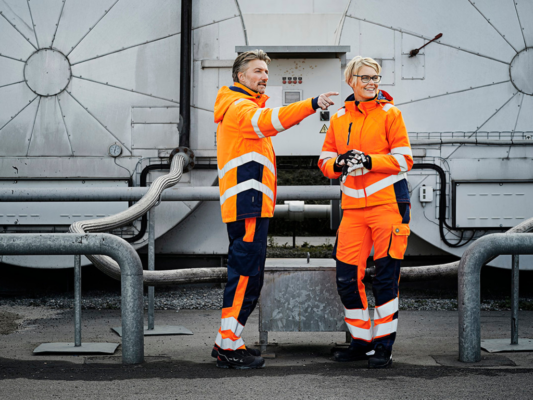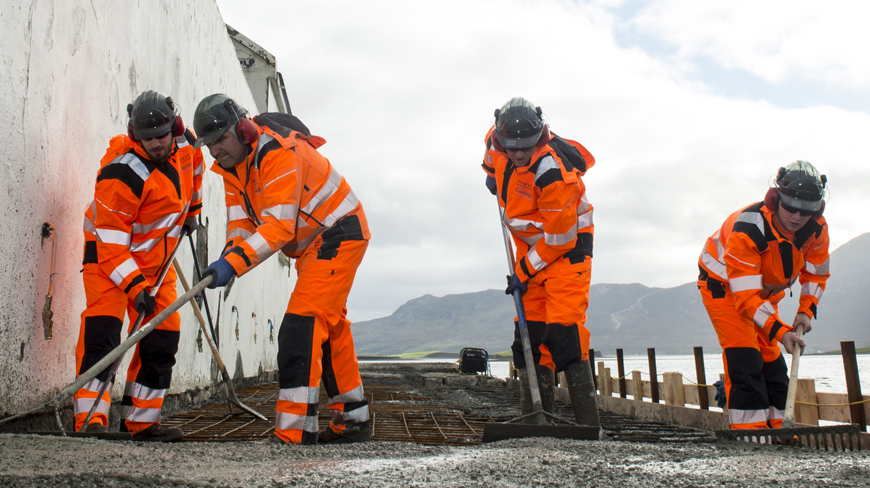No products in the basket.
High Visibility Clothing, Workwear
When Does High Visibility Clothing Need To Be Replaced?
Why High Visibility Clothing Loses Its Effectiveness After 25 Washes
As the name suggests, high visibility clothing is worn whenever the wearer needs to be easily seen. For instance, extra visibility may be necessary in low light conditions, or to warn passing trains or vehicles of the wearer’s presence. It is a requirement when health and safety policy requires hi vis clothing compliant with EN 20471 or railways standard RIS-3279-TOM.
But as with any type of clothing, after a certain time, its integrity will deteriorate, especially after being put through several wash cycles. When this happens with high visibility clothing, the garment may no longer be compliant with EN 20471. This puts the wearer at risk of serious injury, especially on a busy construction site or any other applicable environment where clear visibility of workers is essential.
It is widely recommended to replace high visibility clothing after it has been washed 25 times. Here is a further explanation of why this is important, along with our top tips for prolonging the life of your high visibility clothing as much as possible.
High Visibility Clothing: An Overview
Garments such as jackets, trousers and coveralls can all be manufactured as high visibility clothing. Some of the common fabric colours used to make his vis clothing include yellow and orange, with silver toned reflective stripes being another main characteristic of this type of safety gear. Two-tone styles are also available with hi vis yellow and navy or hi vis orange and navy being very popular.
Five key reasons why high visibility clothing may need to be worn include:
- Safety
- Legality
- Identity
- Professionalism
- Extra protection from the elements
It is the responsibility of the site manager to ensure the appropriate garments are worn whenever there is a danger to workers. Furthermore, the HSE states that high visibility clothing “must be provided free of charge to any employees who are exposed to significant risks to their safety.”
Read more: Clad Safety’s Guide To High Visibility Clothing (EN ISO 20471).
Is Your High Vis Compliant?
EN ISO 20471 – The ISO is an independent body that sets safety standards for various industries. EN ISO 20471 relates to the colour and the performance of the high visibility clothing. It also dictates the placement of any reflective elements to ensure they are visible from all angles, as well as from long distances away (including in various lighting conditions).
Leo Workwear also states: “All EN ISO 20471 garments are certified to a specific number of washes, from as little as 5 to 100, which basically means the product will still conform once it has been washed for the X amount Certified. Our garments are generally certified to 25 and 50 washes.”
It’s worth noting that a handful of brands such as Leo Workwear manufacture garments which guarantee more than 25 washes for high vis clothing. Employers or buying managers must check the specifications of the particular garment to ensure compliance, as this is the exception rather than the rule.
RIS-3279-TOM – A specific standard used by UK rail industry workers, relating to the colour and luminosity of garments. It applies consistency across all garments worn by workers, ensuring they can be seen by passing trains or vehicles. This specification was formerly known as GO-RT 3279. It applies to high visibility orange.
Read more: What Is The High Visibility Standard For Rail Clothing?
Need further advice on high vis clothing compliance for your specific industry or usage requirements? Give our team a call on 0800 161 3661.
When Does High Visibility Clothing Lose Its Effectiveness?
How you take care of your hi vis clothing will impact how quickly the garment loses its effectiveness. But so too will the level of usage the garment receives. In some instances, high visibility clothing needs to be worn at all times. On other sites, it’s only occasionally required, meaning the garment will be subject to less wear and tear, thus prolonging its lifespan.
In any case, high visibility clothing has a life expectancy of around 25 washes. Ironically, hi vis clothing must be kept clean so that its brightly coloured fabric and reflective stripes are fully visible and therefore compliant. However, after being put through the wash cycle many times the reflective properties will diminish.
How Often Should High Visibility Clothing Be Replaced?
High visibility clothing should be replaced when it has reached the maximum recommended times to be washed, which is 25 washes unless otherwise stated by the manufacturer.
Garments will also be replaced if they are found to be defective in terms of quality, or no longer possess high visibility qualities for any other reason.
Some of the warning signs your high visibility clothing needs replacing include:
- The fabric has significantly faded (comparing it against a new garment is an easy way to check)
- The reflective stripes are no longer visible from 1,000 feet away (304.8m) in the applicable lighting conditions
- The garment has any tears or rips or generally appears in poor condition
- The garment has been through 25 wash cycles
- Any other health and safety concern has been flagged with the garment
Similar to regular clothing, the quality of the materials and overall production will also dictate how often a garment needs replacing. In some cases, high visibility clothing may be built to withstand more than 25 washes without losing effectiveness. For example, the Kingford EcoViz® Stretch Cargo Trouser is certified to last up to 50 wash cycles.
This is just one of the many reasons why purchasing your high visibility clothing from a trusted workwear and PPE supplier such as ourselves here at Clad Safety is highly recommended.
Shop Clad Safety’s full range of high visibility clothing.
Top Tips For Keeping Your Hi Vis Workwear In Good Condition
- Follow the manufacturer’s laundry instructions on the label of the garment
- Avoid hot temperatures
- Avoid using bleach
- Never use fabric softener on high visibility clothing
- Never iron high visibility clothing
- Do not tumble dry
- Wash garments inside out to protect the reflective stripes
- Use a wipe on minor stains that do not warrant a wash cycle
Although these tips will prolong the lifespan of your safety clothing, it’s important to remember that the ‘high visibility 25 washes’ rule still applies, unless more washes have been guaranteed by the manufacturer.
Clad Safety – High Visibility Workwear Suppliers UK
In search of high visibility clothing for your team? Clad Safety is a leading supplier of workwear and PPE, including high visibility clothing. Some of the brands we stock include Elka, Leo, Orbit, Portwest and Pulsar.
Geared towards procurement managers, health and safety managers and buying teams from large organisations, Clad Safety serves various industries including Construction, Health, Rail and Utilities.
Need any further help on anything we’ve mentioned above? Or want to place an order with us? Give us a call today on 0800 161 3661 or email us at [email protected] for further information.




